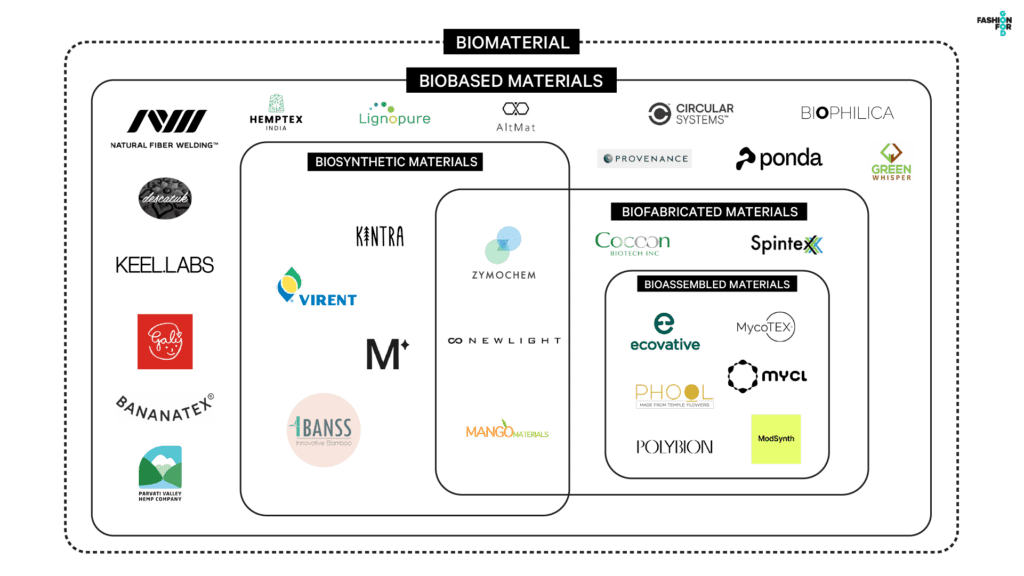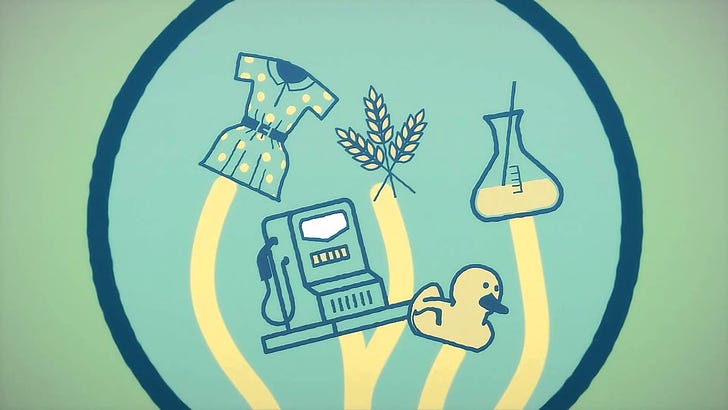Last month, I (representing Beyond Impact) was invited to attend Rethinking Materials, organized by Rethink Events. It was quite an enlightening experience as we (Beyond Impact) have a strong track record of investing in biotechnology and bioeconomy that decouples our dependence on animals for economic growth.
We have minimal exposure to materials as most of our investments tend to have applications in the food & skincare space. Even before the conference, we believed we wanted to play a role in this space, as biomaterials or next-gen materials have an enormous impact on animals & aquatic life, either directly or indirectly.
Interestingly, many technology stacks we see in next-gen food and biopharmaceuticals1 are the same in the materials space. Although the application of these technologies to the materials space is relatively new, they have a widespread impact on the climate and the lives of animals and humans.
I don’t hear much about these biomaterials' potential role in curbing climate change. It is not just plastics but textiles, building materials, pharmaceuticals, etc.
The most interesting argument that I left to ponder is durability vs. degradability. Durability is the ability of a physical product to remain functional without requiring excessive maintenance or repair when faced with the challenges of regular operation over its design lifetime. Degradability is the capacity to be decomposed chemically or biologically. I believe there is a delicate balance between providing functional durability. At the same time, the material is being used in its natural environment and its potential to degrade when the material is no longer being used. Trust me, it's easier said than done.
Let us try to see why biomaterials are an untapped climate opportunity.
Bioplastics2 currently represent roughly 0.5 percent of the over 400 million tonnes of plastic produced annually*. Global bioplastics production capacity is set to increase significantly from around 2.18 million tonnes in 2023 to approximately 7.43 million tonnes in 2028. Of the more than 6.3 billion tons of plastics produced globally over the past 60 years, about 9% were recycled into secondary raw materials, and about 12% were utilized by incineration3.
The global synthetic fibers4 market was valued at USD 66.11 billion in 2022 and is expected to grow at a compound annual growth rate (CAGR) of 7.4% from 2023 to 2030.
According to studies from the United Nations Industrial Development Organisation (UNIDO), the market for animal leather worldwide is estimated to be worth nearly USD 100 billion annually.
The wool market size5 is estimated at USD 38.97 billion in 2024 and is expected to reach USD 45.61 billion by 2029, growing at a CAGR of 3.20% during the forecast period (2024-2029). According to FAO, the sheep population in China increased from 163.49 million in 2019 to 173.01 million in 2020.
The global silk market6 is valued at USD 17.2 billion in 2022 and is projected to grow to USD 28.5 billion in 2030.
According to McKinsey & Co.’s Fashion on Climate report7, the fashion industry was responsible for 2.1 billion tonnes of metric tons of GHG emissions in 2018 — about 4% of the global total and around the same quantity of GHGs per year as the entire economies of France, Germany, and the United Kingdom combined.
These are not small markets, and our dependence on animals and petroleum-based products is causing substantial environmental degradation, damage to the local ecosystem, biodiversity loss, polluted water sources, rise in GHG emissions, and acceleration in rising temperatures. As I said in my last post, we need to think beyond energy transition if we are serious about decarbonization and press on solutions that help us transition consumption in materials, food, medicines, skincare, etc.

We at Beyond Impact look at decoupling our dependence on animals for economic growth, and we see direct and indirect impacts of these existing materials on the animals - both on land & sea. Petroleum-based products are not a sustainable solution. Once, every cloth we used to wear used to come from animals (or some sort of animal source), and now a significant amount comes from petroleum, even if it is not taking the lives of animals directly but indirectly because of contamination of water bodies and land sites. We need to replace every non-biodegradable plastic-based solution with biodegradable using biotechnology, green chemistry, upcycling, etc.
“In aquatic invertebrates, microplastics cause a decline in feeding behavior and fertility, slow down larval growth and development, increase oxygen consumption, and stimulate the production of reactive oxygen species. In fish, the microplastics may cause structural damage to the intestine, liver, gills, and brain while affecting metabolic balance, behavior, and fertility; the degree of these harmful effects depends on the particle sizes and doses and the exposure parameters.” - Harmful effects of the microplastic pollution on animal health: a literature review by Natalia Zolotova, Anna Kosyreva, corresponding author Dzhuliia Dzhalilova, Nikolai Fokichev, and Olga Makarova.
We can’t continue hampering nature for our consumption; we need to find creative ways to decouple our dependence on animals and, in turn, alleviate their suffering as well as prevent biodiversity loss. We feel excited about these biomaterials. Not only because they don’t have microplastics but also because many of them can significantly help improve aquatic life. For example, many biomaterials are based on macroalgae like seaweed, and seaweed farming can improve the pH balance of ocean water and provide oxygen, assisting marine life in adapting to warmer waters8.
We will look at this space within Beyond Impact and hopefully make some commitments in the form of investments. If you are building a company in the space, we would love to hear from you, especially if it aligns with our core thesis of climate impact via having an animal-free lens.
Sign-off for humanity,
Sagar Tandon
Follow me on LinkedIn» https://www.linkedin.com/in/sagartandon/
Mail me at » sagar@beyondimpact.vc
Stay humble, stay curious 🌟🌟🌟!
Note: These are my personal opinion.
A biopharmaceutical, is any pharmaceutical product manufactured in, extracted from, or semisynthesized from biological sources.
Alabi et al. (2019) Alabi OA, Ologbonjaye KI, Awosolu O, Alalade OE. Public and environmental health effects of plastic wastes disposal: a review. Journal of Toxicology and Risk Assessment. 2019;5(2):21. doi: 10.23937/2572-4061.1510021
Wool Market Size & Share Analysis - Growth Trends & Forecasts (2024 - 2029)
Fashion on climate report by McKinsey





